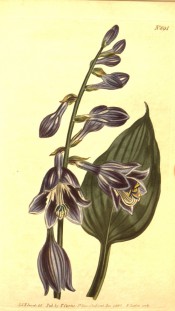Hosta ventricosa (Salisb.) Stearn
Fully-hardy clump-forming perennial with broadly heart-shaped leaves and tubular-bell-shaped deep-purple flowers in summer. To 50cm. [RHSE].
Horticultural & Botanical History
‘[Hemerocallis caerulea is] Thought to bloom best in the stove, but thrives very well in the greenhouse; and some cultivators assure us, that it succeeds in the open ground better than with any other treatment. Introduced by George Hibbert, Esq. Seeds freely, and is easily propagated by offsets.’ [BM t.894/1805]. It was not unusual for newly introduced, often very expensive, plants to be treated as tender at first, their hardiness tested only when they became more widely available.
Paxton’s Dictionary gives a date of introduction of 1790 for Funkia ovata which it describes as synonymous with Hemerocallis caerulea. According to Johnson’s Dictionary, Hosta caerulea was introduced to Britain in 1733 but this may be Hosta caerulea Jacq., a different plant, also known as Cornutia punctata, and figured at BR f.1204/1829. ABR pl.6/1797.
History at Camden Park
Listed in all published catalogues [B.207/1843].
Notes
Published Jan 06, 2010 - 05:16 PM | Last updated Jan 07, 2010 - 01:29 PM
| Family | Hostaceae |
|---|---|
| Category | |
| Region of origin | China, Korea |
| Synonyms |
|
| Common Name | Blue plantain lily |
| Name in the Camden Park Record | Hemerocallis caerulea |
| Confidence level | high |
